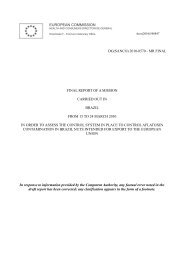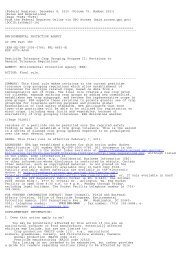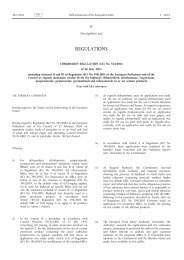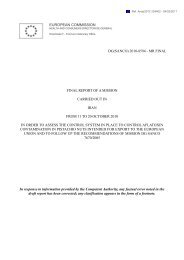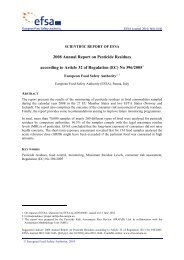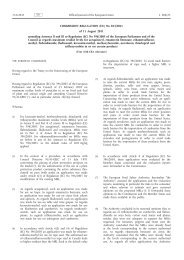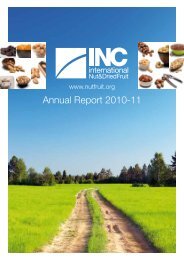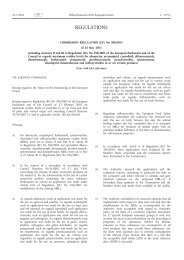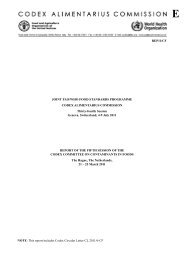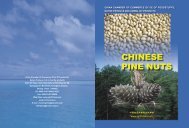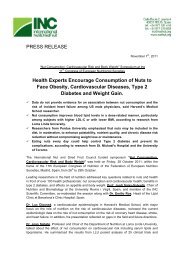REP11/PR JOINT FAO/WHO FOOD STANDARDS PROGRAMME ...
REP11/PR JOINT FAO/WHO FOOD STANDARDS PROGRAMME ...
REP11/PR JOINT FAO/WHO FOOD STANDARDS PROGRAMME ...
You also want an ePaper? Increase the reach of your titles
YUMPU automatically turns print PDFs into web optimized ePapers that Google loves.
<strong>REP11</strong>/<strong>PR</strong> 8<br />
FLUBENDIAMIDE (242)<br />
77. The Committee decided to advance all the proposed draft MRLs for adoption at Step 5/8 noting the reservations of the<br />
Delegations of the EU and Norway regarding the proposed draft MRLs for brassica (cole or cabbage) vegetables, head cabbage,<br />
flowerhead brassicas; fruiting vegetables, cucurbits; legume vegetables, stone fruits due to the extrapolations used by JM<strong>PR</strong> and for<br />
peppers; tomato and tea, green, black (black, fermented and dried) due to insufficient number of trials.<br />
FLUOPYRAM (243)<br />
78. The Committee decided to advance all the proposed draft MRLs for adoption at Step 5/8.<br />
MEPTYLDINOCAP (244)<br />
79. The Committee decided to advance all proposed draft MRLs to Step 5/8 and agreed that the source of the residue be<br />
indicated for each proposed MRL. The Committee noted that the residue definition of meptyldinocap for MRL compliance was<br />
corrected to align it with the JM<strong>PR</strong> recommendation.<br />
THIAMETHOXAM (245)<br />
80. The Committee decided to advance all the proposed draft MRLs for adoption at Step 5/8 in line with the recommendations for<br />
clothianidin (238) noting the reservations of the Delegations of the EU and Norway regarding the extrapolations used by JM<strong>PR</strong> for<br />
berries and other small fruits; brassica (cole or cabbage) vegetables, head cabbage, flowerhead brassicas; citrus fruits; fruiting<br />
vegetables other than cucurbits; fruiting vegetables, cucurbits; leafy vegetables; root and tuber vegetables and stone fruits.<br />
81. The Committee noted that the Delegation of Brazil would submit data and GAP for papaya to JM<strong>PR</strong> to support a higher MRL.<br />
DISCUSSION PAPER ON THE APPLICATION OF <strong>PR</strong>OPORTIONALITY IN SELECTING DATA FOR MRL ESTIMATION (Agenda<br />
Item 6) 8<br />
82. The Committee recalled that at its last session it had noted the concerns expressed by a delegation that JM<strong>PR</strong> had not<br />
recommended MRLs for some commodities as application rates in supporting residue trials were more than 25% greater than the<br />
critical GAP (cGAP) application rates (the JM<strong>PR</strong>/OECD cut-off point). The Committee agreed that the Delegation of Australia would<br />
prepare a discussion paper to address the application of proportionality in selecting data for MRL estimation for consideration at its<br />
next session. 9<br />
83. The Delegation of Australia made a presentation based on the information provided in CX/<strong>PR</strong> 11/43/4 including practical<br />
examples of application of proportionality based on types and rates of application, chemical/commodity combinations and associated<br />
MRLs. The Delegation drew the attention of the Committee to the recommendation in the working paper by which JM<strong>PR</strong> could apply<br />
proportionality in those cases where the residue data according to GAP were not sufficient for a recommendation. The Delegation<br />
noted that this approach would give greater flexibility to JM<strong>PR</strong> in the use of residue field trial data and would allow MRL estimates to<br />
be made in situations where the current ±25% rules excluded such estimates.<br />
84. The Committee noted that there was general support for the application of proportionality by using supporting residue trials<br />
with application rates beyond ±25% in those cases where the residue data according to GAP were not sufficient for a<br />
recommendation. However, it was noted that this situation usually applied to minor crops and should therefore be limited to these<br />
crops as opposed to major crops where availability of data usually allowed for normal residue evaluations. It was also noted that,<br />
when applying proportionality, all data points under consideration, i.e. within/outside the acceptable range of ±25%, should be<br />
adjusted to 1X to prevent issues of bias. It was further noted that the concept of proportionality should be further tested to ensure<br />
reliable results before the Committee endorse this approach for use by JM<strong>PR</strong>. It would thus be helpful to gather information on what<br />
compound/crop combinations the proportionality principles could apply, statistical methods used, number of tests needed, criteria for<br />
application of the proportionality method, etc.<br />
85. The <strong>FAO</strong> JM<strong>PR</strong> Secretariat informed the Committee that relevant information on the proportionality approach was provided by<br />
the 2010 JM<strong>PR</strong> (General Consideration 2.8 of the 2010 JM<strong>PR</strong> Report). In this regard, the 2010 JM<strong>PR</strong> had also recommended<br />
principles for use of proportionality, including general aspects, commodity and application types, etc. The 2010 JM<strong>PR</strong> Report also<br />
presented examples on how to use these principles and the statistical method.<br />
8 CX/<strong>PR</strong> 11/43/4. Comments from the EU (CRD16). Section 2.8, 2010 JM<strong>PR</strong> Report.<br />
9 ALINORM 10/33/24 paras 72-73.



